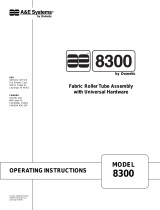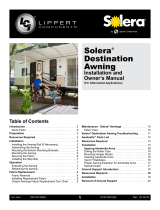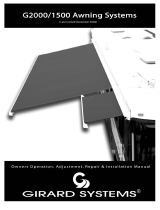Page is loading ...

1
USA
SERVICE OFFICE
The Dometic Corp.
509 So. Poplar St.
LaGrange, IN 46761
CANADA
Dometic Dist.
866 Langs Dr.
Cambridge, Ontario
CANADA N3H 2N7
Form No. 3106131.000 1/95
©1994,1995 The Dometic Corp.
LaGrange, IN 46761
INSTALLATION
INSTRUCTIONS
Fabric Roller Tube Assembly
with "Nested" Universal Hardware
™
®
by Dometic
MODEL
8300

2
REQUIRED PARTS (Packed with each Hardware Assembly)
Application
The A&E Awning is designed and intended for use on
motorhomes, mini-motorhomes, 5th wheels and travel trail-
ers with straight sides.
IMPORTANT: Read ALL of the following steps before
beginning installation.
The Dometic Corporation reserves the right to modify ap-
pearances and specifications without notice.
Installation of A&E Awnings will at some points, require three
people. Use the following procedure to assure a properly
installed, and properly functioning awning.
Position Wheel
Directly over edge
of Door
Wheel Above
Door 1/4" – 3/8"
ENTRY
DOOR
FIG. 1A
DOOR EDGE
GUARD
SCREEN
DOOR
FIG. 1B
1. Where the A&E Awning is to be mounted above the entry
door, the door roller must be installed on the exterior side
of the door in the extreme upper corner above the door
handle. (FIG. 1A)
In addition, if there is a screen door inside the regular
door, a door edge guard must be installed on the exterior
side of the screen door, in the extreme upper corner
opposite the door hinges. (FIG. 1B)
This allows the door roller or the edge-guard (instead
of the sharp door corner) to contact the underside of the
fabric when the entry or screen door is swung out while
the awning fabric is extended low.
2. Carefully lay the fabric roller tube assembly on a clean,
well padded "V" trough to prevent fabric damage. Secure
both arm assemblies to the respective torsion rods using
the 1/4–20 hex cap screws, nylon washers, and 1/4"
locknuts. The right side has the torsion lock lever and the
serial number tag. (FIG. 2)
FIG. 2
(2) 1/4–20 Phillips Machine Screws
(2) 1/4–20 Locknuts
(2) Nylon Washers
(4) #14 x 2 Screws
(4) #14 x 3 Screws
(2) #10 Machine Screws
(2) #10 Locknuts
(2) Stop Washers
(2) #6 Self-Drilling Screws
(1) Door Roller Kit, Containing:
(2) #10 Self-Drilling Screws
(1) Door Roller
(1) Edge Guard
INSTALLATION
COVERED BY PATENT 4,524,791
OTHER PATENTS APPLIED FOR
3. Remove the left nail only. With both awning arms secured
to the Fabric Roller Tube Assembly, twist the roller tube
as if unrolling the fabric, and remove the nail by hand.
DO NOT REMOVE the NAIL from the right end at this time
and DO NOT attempt to rotate the Safe-T-LockTM Lock
Direction Lever until installation is complete. (Lever has
been preset in the roll-down position.)
(FIG. 2)
4. Prepare the awning rail to accept the awning roller cover
by selecting the end from which the awning shall be fed,
then widen that end of the rail with a flat screwdriver and
remove burrs. (FIG. 3)
With one person grasping each support arm, carefully lift
the entire assembly to an upright position.
Keeping the two arm assemblies PARALLEL to each
other to avoid excessive twisting and possible damage
to assembly, walk the awning to the prepared end of the
awning rail (FIG. 4A)

3
BEFORE
AFTER
FIG. 4A
ARM
ASSEMBLIES
AWNING
RAIL FABRIC ROLLER
TUBE ASSEMBLY
TAPE
TAPE
FIG. 3
A third person is now required to guide the full awning into
the awning rail while standing on a stepladder, while the
other two walk the entire awning assembly to the desired
position. (FIG. 4)
5. Additional stability can be gained at this point by lifting
handle (releasing lock button) on the side of the main
arm and CAREFULLY allowing the inside adjustable arm
to extend to the ground (FIG. 5D).
6. Install Top Mounting Brackets.
After the complete awning assembly has been slid into the
awning rail, check to be sure that its position allows for solid
mounting of the top and bottom brackets and that support
arms are in desired location (not restricting use of doors,
access doors, etc.). (FIG. 5A)
Place top bracket in position over awning rail as shown in
FIG. 5B, and align bracket directly behind and centered with
the main support arm.
Pull the main support arm away from the top mounting
bracket and rafter arm. Mark the top bracket position and
predrill the two holes using a 3/16" drill bit. (Use 7/32" drill bit
if drilling through steel). Install top bracket with two #14 x 3"
hex. hd. screws (FIG. 5C). It is recommended that clear
silcon be used to seal the screw where it enters the coach.
Place main support arm over the extension portion of the top
bracket. (FIG. 5B).
FIG. 5A
FIG. 5CFIG. 5B
Connect the patio foot located at the bottom of the adjustable
arm, to the bottom mounting bracket, guiding the shank
portion of the patio foot into its receptacle in the bottom
bracket and allow the patio foot to slip into the bracket.
(FIGS. 6A & 6B). Release the lock button by lifting the handle
on the side of the main arm and slide the adjustable arm up
to the desired mounting position. Always select the position
that offers the best supporting structure for mounting the
bottom bracket, i.e. mounting the bottom bracket directly
into the floorline, molding, etc.
Allow the lock button (in handle) to catch one of the pre-
punched holes that are spaced 3/4" apart.
Once again, check to be sure that the top portion of the main
arm is still temporarily resting over the top bracket. Mark
position of bottom bracket so that both holes are positioned
over the floorline. Disconnect bottom bracket from patio foot
and pre-drill two 3/16" dia. holes through the marked loca-
tions. (Use 7/32" dia. if drilling through steel).
FIG. D
FIG. 6A
FIG. 6B
Install remaining top mounting bracket using the same
procedure.
7. Installation of Bottom Mounting Brackets.

4
After both bottom brackets are installed, and both main
support arms are engaged into pre-punched push button
holes on the adjustable arms, depress the push button on
one main arm and RAISE THE MAIN ARM UP BY ONE
HOLE ONLY.
On the front of the adjustable arm, locate the small 3/16" dia.
hole which is closest to the bottom of the main arm (FIG. 7).
Install aluminum stop plug in this hole by inserting a #10 x
5/8" phillips screw through the stop plug and through the
hole. Secure with a #10 lock nut (FIG. 7).
THE MAIN SUPPORT ARM SHOULD NOW COMPLETELY
CLEAR THE TOP BRACKET AS IT SWINGS TOWARD
THE VEHICLE SIDE.
Repeat for other side.
FIG. 7
MAIN ARM
ALUMINUM
STOP PLUG
#10 x 5/8"
PHILLIPS HD.
SCREW ADJUSTABLE
ARM
3/16" DIA. HOLE
CLOSEST TO
MAIN ARM
#10 LOCK NUT
FIG. 6C
Secure bracket using two #14 x 2" hex head screws. (FIG.
6C).Seal the screw where it enters the coach.
Repeat for other side.
FIG. 6D
9. Releasing Pre-Set Tension.
When removing nails, keep hands clear of hardware and
roller tube. Springs are under tension and the awning
will attempt to close.
The nail is found in the roller tube end cap (FIG. 8). Twist the
roller tube as if unrolling awning while pulling the nail by hand
and discard.
Remove wire tie from the Safe-T-Lock™ Lever. Rotate the
lever to the roll up position and allow the awning to roll up.
The awning should now roll up snugly against the vehicle
side. If no tension is felt, check to make sure the Safe-T-
LockTM Lever is in the roll-up position.
FIG. 8
The bracket MUST be mounted level.
If installing over a molding, A&E Standoff Kit 3104781
may be used (See Fig. 6D).
8. Installation of Stop Plugs.
CAUTION: This step is essential for the proper function-
ing of all A&E Awnings.

5
10.Securing Awning
The fabric must be secured from shifting within the awning
rail.
Open and close awning a few times to allow for natural self
adjustment of awning. Track the strap slightly to one side as
it closes to avoid bulging over the extra thickness of material
and stretching the fabric.
With the awning closed, the fabric will locate itself between
the two top brackets. Pull the fabric sideways 1/4" in the
awning rail. Measure in 2" from the edge of the fabric and
secure by driving a #6 self-drilling screw through the rail and
into the fabric rope. (FIG. 9)
Repeat at the other end, pulling the fabric 1/2" and holding
while securing the fabric. This will ensure a wrinkle-free
weather shield.
11. Operate awning according to the Operating Instructions
to check that all parts function properly.
12. Secure the travel latches.
FIG. 9
/




